Basic Guitar Chords for Beginners
This page is designed for aspiring guitarists looking to grasp fundamental, easy-to-play guitar chords. Mastering these chords serves as a stepping stone toward learning more advanced ones.
We start with 'open chords' which simply means guitar chords played in an open position - no barre chords. The reason for that is that barre chords are built around open chord positions. Once you have a solid grounding of open chords, barre chords are a 'walk in the park'.
We also offer a dedicated page tailored for left-handed guitarists — because everyone deserves to play regardless of which hand they strum with!
Fingers & Fretboard

Firstly, when learning guitar chords, there are a few things to learn when reading the following charts. Each finger on your hand has a number which shows you what finger to use on each string.
- T = Thumb
- 1 = Index
- 2 = Middle
- 3 = Ring
- 4 = Pinkie
Although the thumb is rarely used, it does come in handy especially when you play bass notes and the other fingers are required for playing the chord, or it may be 'stretch' to play the chord and bass note using 4 fingers, e.g. D/F#. You can simply play the D chord as usual and use the thumb to play the bass note F#.
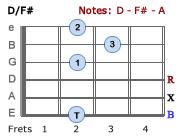
The next thing we need to look at is the guitar fretboard, which includes the nut, the frets and the strings. Notice that the strings are all a different thickness. Top E (string 1) is the thinnest string with the highest tone, while bottom E (string 6) is the thickest string with the lowest tone.
Please note that we use the term 'fretboard' as opposed to 'fingerboard' because of the presence of frets. Stringed instruments that don't have frets use the term 'fingerboard', i.e. fretless bass, double bass, cello, violin, etc.
Although you won't be playing any barre chords in this session, I have included a barre line in the diagram, so that you are familiar with it for later sessions. In the following diagram, the first finger uses a barre to cover the first 5 strings on the first fret.

Basic Guitar Parts
1. Frets / Fret WiresFret Wires are the metal strips that are set into the entire length of the fretboard at right angles to the strings.
Frets are the spaces between the fret wires where the notes are played and fret markers are placed.
You can see this clearly on the diagram above... notes played on the first fret are on the 1st space after the nut; notes played on the second fret are on the second space after the nut; notes played on the third fret are on the third space after the nut, etc.
These positions are all depicted by the fret numbers and finger positions which you will find on all the chord charts..
When you press a string down on a fret, you are shortening it. The length of the string is one of the factors that determine the pitch of the note.
The shorter the string, the higher the note. The longer the string, the lower the note. As you move up each fret, you are moving up one semitone higher than the fret below it. So, if you play the open E string (1st string) and then hold down the first fret, you are playing an F. If you then hold down the second fret, you play an F# and so on.
2. The Nut & the Saddle: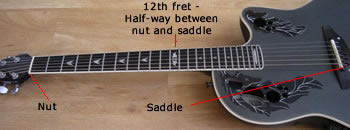
The 12th fret is located halfway between the nut and the saddle. The saddle is situated on the guitar body where the strings end, and is usually made of bone, ivory, plastic, or other synthetic material depending on the quality of the guitar.

The saddle sits in a groove on the bridge and has 6 or 12 notches depending on the number of strings your guitar has. These notches prevent the strings from moving around, especially if you are playing fairly hard.
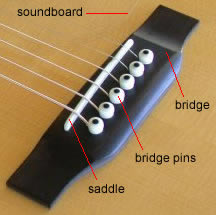
The vibration of each string begins at the saddle and ends at the nut. The vibration from the strings are also transmitted through the bridge to the soundboard. The saddle can affect many important aspects relating to the sound of the guitar including the tone, volume, and tuning, with the natural materials (bone or ivory) resulting in better vibration transfer and greater volume levels.
The 12th fret divides the vibrating string in half which means that the note on the 12th fret has the same pitch as the open string, but is one octave higher. Therefore, if you hold down the 13th fret on the first string, you are playing an F; hold down the 14th fret, you play F# and so on... the pattern starts all over again, except the notes are one octave higher.
3. Fret Markers:

Guitars also display Fret Markers or Inlays which come in the form of dots or other shapes depending on the manufacturer. They are inserted into the fretboard along its entire length. You will generally find them on the 3rd, 5th, 7th, 9th 12th, 15th, 17th, 19th, 21st and 24th frets (if your guitar has a long enough neck). They enable you to move around the fretboard quickly and easily and know exactly where you are at any given time. As you learn more, you will understand the importance of these, especially if you are playing barre chords or lead guitar.
Which Chords First?
So which chords should you learn first? Easy open chords as opposed to barre chords which requires a good knowledge of essential open chords as they form the foundation of most barre chords.
If you're new to playing the guitar, beginning with the easiest open chords is your ideal starting point. Our focus will be on chords positioned within the first three frets, commonly known as the first position chords
When you see an 'X' next to a string, it means you don't play that string. If you do, it will give the chord a 'discordant' sound which is not very pleasing to the ear. Don't worry about that too much because the more you play and the more confident you become, the less the tendency will be to play these notes.
Horizontal View:

Unlike the typical vertical view of guitar chords on the neck, our display showcases them horizontally, mirroring your natural perspective while playing—looking down at the fingerboard. Both the chord photos and charts maintain this horizontal view, often referred to as Horizontal Charts, providing a more intuitive representation.
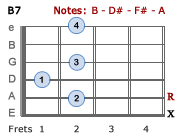
The chord in this picture is a B7 chord. This chord is probably one of the hardest basic guitar chords you will learn, but with practice it becomes very easy to play. Try to remember the shapes of the chords, so that you have a mental picture of where your fingers need to go before you actually play the chord. Here it is in chart form:
15 Essential Guitar Chords for Beginners
There are several ways to play the following chords, but we will be looking at the easiest and most common ways to play them.
The E chord is the easiest of all the basic guitar chords, as you can strum all 6 strings and it will always sound great. Also, by taking off one finger, you can play an E7 or Em chord.
Numbered Circles: Fingers
Unmarked strings: Play open
X: Don't play string R: Root Note
Beginner Chords:
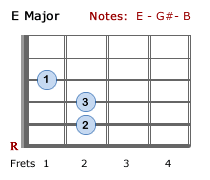

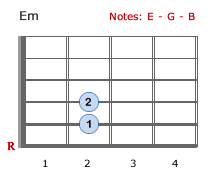
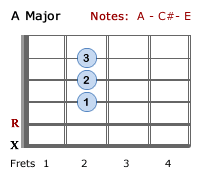
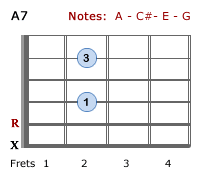
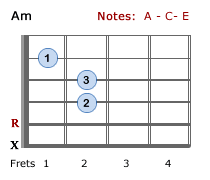
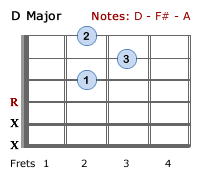
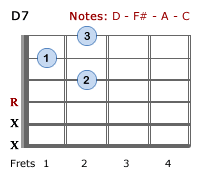
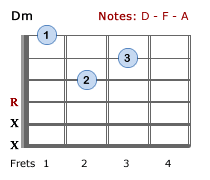
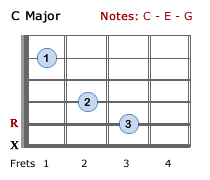
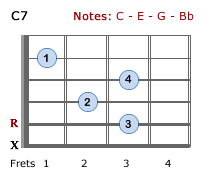
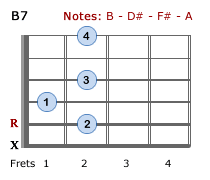
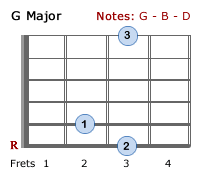
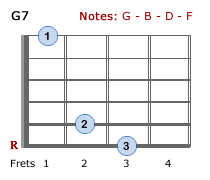

- The C chord requires a little more precision to make the notes sound clearly. This is also true for the B7 chord, but the more you practice, the easier it gets.
- The F major chord requires you to use your first finger to play 2 strings at once. This is a small or simple barre. It seems hard at first, but make sure your thumb supports your first finger by providing pressure directly behind the barre on the back of the guitar neck.
- The G chord can be played using fingers 2, 3, and 4. Finger 1 becomes finger 2, finger 2 becomes 3, and finger 3 becomes 4. This is useful if you are playing a G chord followed by a G7 chord or vice versa.
- From G to G7, you simply take off the 4th finger and add the 1st finger while leaving fingers 2 and 3 unchanged.
- From G7 to G, you take off the 1st finger and add the 4th finger leaving fingers 2 and 3 unchanged.
- Make sure you practice these basic guitar chords until you can play them smoothly and cleanly flowing from one chord to the next without worrying about where your fingers need to be. You must hear every string ring clearly with no muffled sounds. Once you achieve this, you are ready to move on. You can go to the guitar chords section for more open chords or you may want to get started on barre chords or even power chords.
For beginners, mastering the basic chords is crucial. These fundamental chords are not only the easiest but also serve as the cornerstone for building a strong musical base before advancing to the next level
↓ Basic Guitar Chords Chart for beginnersC Major and F Major with Leading Bass Notes
These extra notes can be useful, particularly if you enjoy incorporating alternating bass notes into your strumming or picking technique. You might come across chords like C/G (a C Major chord with a leading G bass note) and F/C (an F Major chord with a leading C bass note). Pay attention to the adjusted positions of fingers 3 and 4 to fit the extra string. While these variations might not be used all the time, it's good to know them. Just remember to avoid playing the extra string if you’re not including the added bass note.
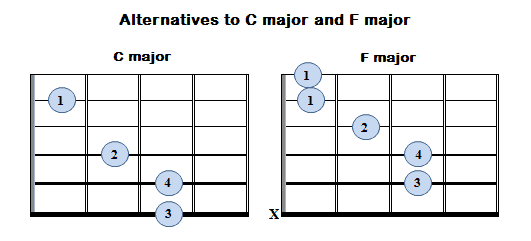
Easy Guitar Songs for Beginners
Below is a collection of songs ideal for practice, featuring beginner chords with comprehensive charts and accompanying play-along videos. Playing along with these tunes will help you get comfortable with jamming alongside others. Listen carefully, immerse yourself into the 'feel of the song', and most importantly, enjoy the music!
- Beautiful Things - Benson Boone
- Bonfire Heart - James Blunt
- Count On Me - Bruno Mars
- Counting Stars - OneRepublic
- Demons - Imagine Dragons
- Ex's & Oh's - Elle King
- Girl Crush - Little Big Town
- I Won't Let You Go - James Morrison
- If Tomorrow Never Comes - Ronan Keating
- Jersey Giant - Elle King
- Me & Bobby McGee - Janis Joplin
- Only Love Can Hurt Like This - Paloma Faith
- Perfect - Ed Sheeran
Considerations
For the serious beginner
If you are serious about a good solid foundation in guitar incorporating excellent guitar technique, you may want to consider studying classical guitar... even for a short time. Your hand, finger, and playing technique will improve tenfold, especially if you love fingerpicking. You don't have to become a classical guitarist, but you will certainly be glad you went through the exercise.
If you do decide to learn classical guitar, ask your teacher about Aaron Shearer Classic Guitar Technique, Vol 1 (Book & CD). It has been around forever and there's a reason for that. When I studied classical guitar, this book was a pre-requisite... I couldn't put it down. It weaves you from lesson to lesson with excellent instruction and useful exercises which become a little more challenging with every lesson.
Whether you are playing guitar, piano, or any instrument, classical training at the onset can be extremely beneficial. It develops good grounding, correct 'playing technique', and improves your reading and understanding of music notation. It helps to iron out incorrect 'habits' from the onset, paving the way forward in your musical development.
One more thing!
For the very young, usually less than 8 - 12 years of age, a full-size guitar may prove very difficult due to small hands trying to span wide frets. Also, a steel string guitar can prove very uncomfortable for young hands. If you or your child is young with a small hand size, you may want to consider 3/4 guitars with nylon strings. The frets are easier to reach as they are narrower, and the nylon strings are a lot easier on the fingers, making playing more enjoyable... something to think about.
When you start playing guitar, your fingers will become very tender and 'hurt like crazy', but it does get better. After a few weeks or months depending on how often you play, you will start developing callouses or thicker skin on your fingertips. When this happens, playing will be a breeze.
You can make it easier on yourself if you start with a nylon string guitar (classical guitar), and then move onto a steel string guitar. The choice is yours. Remember, perseverance is golden...
If you get the chance, go to your nearest guitar store and get a 'feel' for all the different types of guitars - hold them, play them, try the 3/4 guitars if you are a youngster, and most importantly, choose a 'comfortable fit'. For online shoppers, Amazon is a good starting point with a vast array of choices for young and adult beginners.
We hope you have enjoyed this session on Guitar Chords for beginners. If you have any questions or would like to offer any suggestions, we would love to hear from you (see below for contact details).
